9.2 /10 1 Votes9.2
4.5/5 Let's Play SEGA Producer(s) Scott Berfield Initial release date 1993 | 4.4/5 Emuparadise 4.8/5 CoolROM Mode(s) Single player Series Strike Genre Shoot 'em up | |||||||||||||||||||||||||||||||||
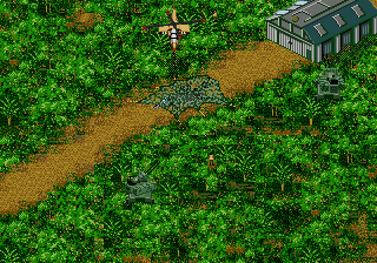 | ||||||||||||||||||||||||||||||||||
Designer(s) John Manley, Tony Barnes Publishers Electronic Arts, Ocean Software, Gremlin Interactive, Amiga, Inc., Black Pearl Software, Malibu Games Similar Strike games, Shoot 'em up games | ||||||||||||||||||||||||||||||||||
Jungle strike walkthrough gameplay sega genesis
Jungle Strike is a video game developed and published by Electronic Arts in 1993 for the Sega Mega Drive. The game was later released on several other consoles such as the Super Nintendo Entertainment System (SNES), and an upgraded version was made for the Amiga. The Amiga and other home computer conversions were the responsibility of Ocean Software while the SNES version was that of Gremlin Interactive. It is the direct sequel to Desert Strike: Return to the Gulf (a best-seller released the previous year) and is the second instalment in the Strike series. The game is a helicopter based shoot 'em up, mixing action and strategy. The plot concerns two villains intent on destroying Washington, D.C.. The player must use the helicopter and occasionally other vehicles to thwart their plans.
Contents
- Jungle strike walkthrough gameplay sega genesis
- Mega drive longplay 173 jungle strike
- Plot
- Gameplay
- Development and release
- Reception
- References
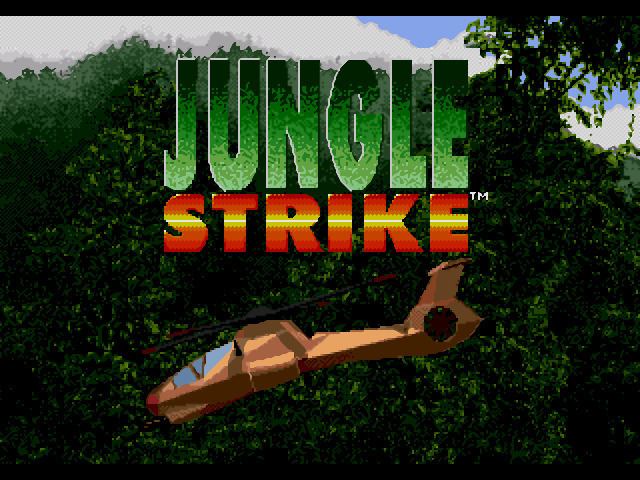
Its game engine was carried over from a failed attempt at a flight simulator and was inspired by Matchbox toys and Choplifter. Jungle Strike retained its predecessor's core mechanics and expanded on the model with additional vehicles and settings. The game was well received by most critics upon release, with the Mega Drive release receiving critical acclaim from their respective reviewers. Publications praised its gameplay, strategy, design, controls and graphics, although there were some complaints regarding the interface, difficulty and perceived jingoistic politics.
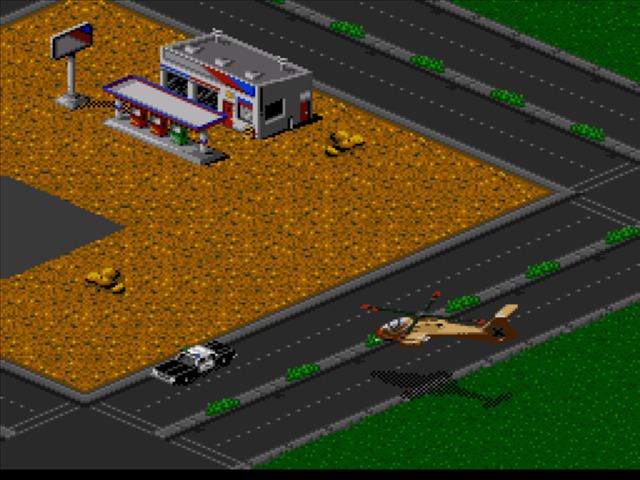
Mega drive longplay 173 jungle strike
Plot
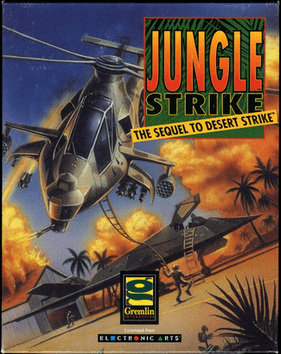
Jungle Strike features two antagonists: Ibn Kilbaba, the son of Desert Strike's antagonist, and Carlos Ortega, a notorious South American drug lord. The opening sequence depicts the two men observing a nuclear explosion on a deserted island, while discussing the delivery of "nuclear resources" and an attack on Washington D.C.; Kilbaba seeks revenge for his father's death at the hands of the US, while Ortega wishes to "teach the Yankees to stay out of my drug trade".
The player takes control of a "lone special forces" pilot. The game's first level depicts the protagonist repelling terrorist attacks on Washington, D.C., including the President's limousine. Subsequent levels depict counter-attacks on the drug lord's forces, progressing towards his "jungle fortress". In the game's penultimate level, the player pursues Kilbaba and Ortega to their respective hideouts before capturing them.
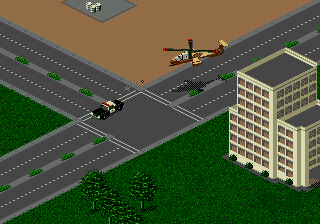
The final level takes place in Washington, D.C. again, where the two antagonists attempt to flee after escaping from prison. The player must destroy both Kilbaba and Ortega and stop four trucks carrying nuclear bombs from blowing up the White House. The PC version also extends the storyline with an extra level set in Alaska, in which the player must wipe out the remainder of Ortega's forces under the command of a Russian defector named Ptofski, who has taken control of oil tankers and is threatening to destroy the ecosystem with crude oil if his demands are not met. Once all levels are complete, the ending sequence begins and depicts the protagonist and his co-pilot in an open-topped car in front of cheering crowds.
Gameplay
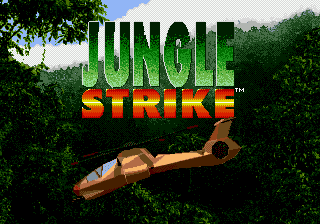
Jungle Strike is a helicopter-based shoot 'em up, mixing action and strategy. The player's main weapon is a Comanche attack helicopter. Additional vehicles can be commandeered: a motorbike, hovercraft and F-117. The latter in particular features variable height and unlimited ammunition, but is more vulnerable to crashes. The game features an "overhead" perspective "with a slight 3D twist". The graphics uses a 2.5D perspective which simulates the appearance of being 3D.
Levels consist of several missions, which are based around the destruction of enemy weapons and installations, as well as rescuing hostages or prisoners of war, or capturing enemy personnel. The helicopter is armed with machine guns, more powerful Hydra rockets and yet more deadly Hellfire missiles. The more powerful the weapon, the fewer can be carried: the player must choose an appropriate weapon for each situation. Enemy weapons range from armoured cars, to artillery and tanks.
The player's craft has a limited amount of armour, which is depleted as the helicopter is hit by enemy fire. Should the armour reach zero, the craft will be destroyed, losing the player a life. The player must outmanoeuvre enemies to avoid damage, but can replenish armour by means of power-ups or by airlifting rescued friendlies or captives to a landing zone. The helicopter has a finite amount of fuel which is steadily depleted as the level progresses. Should the fuel run out the Comanche will crash, again costing the player a life. The craft can refuel by collecting fuel barrels. The helicopter also carries limited ammunition, which must be replenished by means of ammo crates.
Development and release
Jungle Strike is the sequel to Desert Strike: Return to the Gulf, a similar game which parodied the Gulf War and which was released in 1992. Desert Strike arose from a failed attempt at a flight simulator and was inspired by Matchbox toys and Choplifter. Central to the game's concept were nonlinear gameplay and the eschewing of power-ups and bosses. With the success of the original title, producer Scott Berfield, game director John Manley and associate producer Tony Barnes were tasked with creating the sequel. Jungle Strike retained the core mechanics of its predecessor, with the addition of various vehicles and settings. Desert Strike was at the time Electronic Arts' highest selling video game and maintained a high sales chart position as Jungle Strike was released in 1993.
The Amiga conversion of Desert Strike featured upgraded graphics and sound over the Mega Drive original. With regards to the Jungle Strike Amiga conversion, senior programmer Stuart Johnson stated he "tried to keep this conversion a lot more faithful to the Mega Drive version than Desert Strike was". He attempted to make the Amiga conversion run more smoothly than the Mega Drive original. Graphical improvements were attempted: these were less successful on the A500 than the A1200 because of technical restrictions. The developers also struggled with technical challenges because of differences in hardware between the Mega Drive and Amiga. Amendments were also made to the workings of in-mission plot screens. The Amiga conversion was released as sequel Urban Strike was published for the Mega Drive in 1994.
Jungle Strike was followed by three further sequels: Urban Strike, Soviet Strike, and Nuclear Strike. As the series moved to more advanced consoles, series creator Mike Posehn became less involved in the programming side of development. Urban Strike, released for the Mega Drive, featured new vehicles and locations, as well as on-foot sections. Soviet Strike, released for Sony's PlayStation and the Sega Saturn in 1996, featured 3D graphics, as did Nuclear Strike, released on PC and PlayStation in 1997 and the Nintendo 64 in 1999. Another sequel provisionally titled Future Strike was planned, but the game was eventually released as Future Cop: LAPD, a mech-based shooter game.
Reception
The game was well received by critics upon release, with some reviews regarding it with critical acclaim. Adrian Pitt and Mat Yeo of Sega Force both reviewed the game. Adrian Pitt called the title a "strategy game" and commented it as the "greatest game in the genre". Pritt said the controls were "without fault" and the graphics "superb". The second reviewer, Mat Yeo, praised the "amazing playability and 'lastability'" and said the game was "twice as good" as Desert Strike. Yeo called the graphics "brilliant" and said the game was "the best shoot 'em up I've seen in a long time". The Mega Drive version was a best-seller for 3 months. MegaTech magazine said the game has "impressive graphics and tons of missions". Mega placed the game at No. 13 in their Top Mega Drive Games of All Time.
Lim Choon Klet of New Straits Times praised the "simply wonderful" graphics but questioned whether the sound effects were enough to "create the environment of a full-scale war". Choon Klet pointed to a high initial difficulty but said: "Once the skills are acquired, be ready for many hours of enjoyment and sleepless nights." Chip and Jonathan Carter of St. Petersburg Times deemed the game one of the best of the year and felt the SNES version "loses nothing in the translation". The duo said the Game Boy and Game Gear versions were "less impressive" due to their technical restrictions but "about as good as you can get on the small screen". "Sir Garnabus" of GamePro was impressed with the Game Boy version's clear and detailed graphics, lack of slowdown, good controls, and faithfulness to the original version, but judged the Game Gear version to be "merely average", saying issues such as poor collision detection hamper the game despite its outstanding graphics. Amiga CD32 Gamer called Jungle Strike "a 500lb gorilla among games" and praised its ease of control and "masses of gameplay and realistic detail".
Amiga Computing said: "With its impressive graphics and superbly designed game system, it could well be the best chopper title yet" although the reviewer felt the difficulty curve was too steep. Amiga Format said of the game: "with a little more foresight and planning, it could have been a lot more fun", as the reviewer was irritated by the fact that fuel, armour and ammunition levels were displayed on map screen. However the magazine also wrote: "The bottom line though, is that Jungle Strike is an incredibly good game". Amiga Power called the game "an appreciable shoot 'em up" but said it was "clearly tailored for the shorter attention span" of a console gamer. CU Amiga Magazine wrote: "This blend of shooting and thinking action blends together seamlessly and in the process creates a classic blaster well worth a ride". The One Amiga magazine wrote: "Jungle Strike's a fine game, which will prove both a challenge for Desert Strike-ophiles, and a good solid blast for first bloods". ACAR observed the game's "Good graphics, okay sound, smooth animation and tough game play." Amiga Power complained that "Throughout the game you're battered with uneasily right-wing US politics", while Amiga Format said "jingoism" was "rife" throughout the game. Amiga CD32 Gamer called the plot "typically 'ugly American' idiocy".
GamePro commented on the game's skilful challenge and variety of locales, and particularly praised the Super NES version for retaining the same gameplay of the Genesis version while improving on the graphics and sound.
